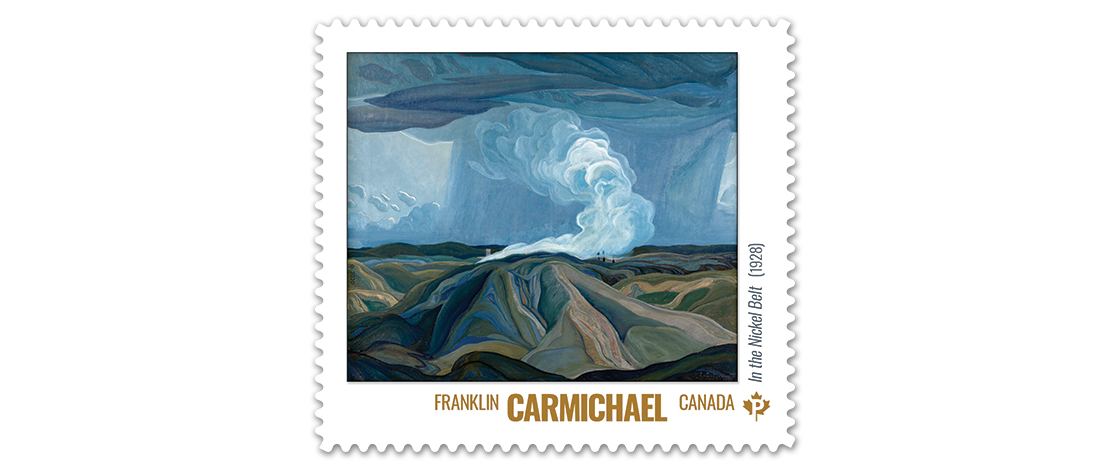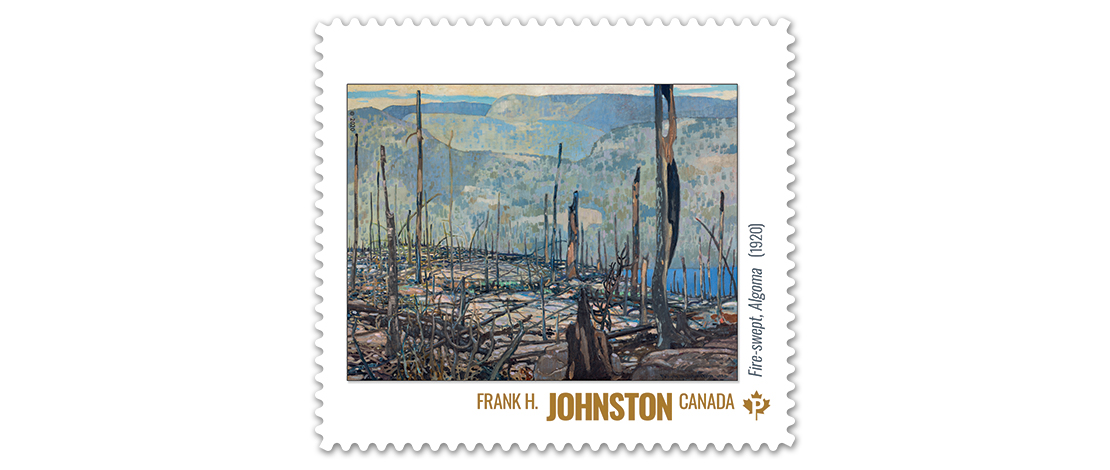“We were told, quite seriously, that there never would be a Canadian art because we had no art tradition.”
– Lawren S. Harris

Miners’ Houses, Glace Bay (circa 1925), Lawren S. Harris
“The group of seven artists whose pictures are here exhibited … are all imbued with the idea that an Art must grow and flower in the land before the country will be a real home for its people.”
– May 1920 exhibition catalogue
On May 7, 2020, Canada Post issued seven stamps to mark the 100th anniversary of the first exhibit by the Group of Seven. Each stamp features a painting by one of the original members.
Before the Group’s formation, painters in Canada borrowed much from Britain and Europe’s ornate, idealized approach. Strongly influenced by fellow artist Tom Thomson, contemporary Scandinavian landscape painting, Post-Impressionism and Art Nouveau, the Group brought a distinctively raw and visionary aesthetic to the art world.

Quebec Village (1926), Arthur Lismer
The seven artists — Franklin Carmichael, Lawren S. Harris, A.Y. Jackson, Frank H. Johnston, Arthur Lismer, J.E.H. MacDonald and F.H. Varley — had supported each other’s work for several years. They often painted together or met for discussions at the Arts and Letters Club of Toronto. Only Harris had the means to paint full time; the rest worked day jobs, many as commercial artists at the legendary design firm Grip Ltd. Seeing the potential to build a uniquely Canadian art tradition, Harris used his personal finances to build a studio and fund painting excursions for the Group. The resulting work — mainly landscapes — changed how Canada was seen at home and abroad, and influenced generations of artists.

In the Nickel Belt (1928), Franklin Carmichael
“The seven artists insisted that the Canadian landscape was distinctive and could not be interpreted through the lenses of Europe and Britain. A new visual language of bold colour, brushwork and form was required to interpret new subjects, Canada’s northlands.”
– Charles C. Hill, author of The Group of Seven: Art for a Nation, and former curator of Canadian Art at the National Gallery of Canada
The Group of Seven’s first exhibition at the Art Gallery of Toronto (now the Art Gallery of Ontario) in May 1920 was attended by more than 2,000 people during its 20-day run. One review praised the “work of men who act on the belief that Canada has a colour scheme and subject interest entirely her own.”

Labrador Coast (1930), A.Y. Jackson
The Group sold only five pieces: two to a private buyer (both by Carmichael) and three to the National Gallery of Canada – Night, Georgian Bay (Jackson), Fire-Swept, Algoma (Johnston) and Shacks (Harris). Capturing the Gallery’s attention, however, proved invaluable, as it went on to organize tours of the Group’s work, which it later included in its reproduction programs. More widely known thanks to this first exhibit, the Group was invited to be a part of the 1924 British Empire Exhibition, where its work received positive reviews in the English press.

Fire-swept, Algoma (1920), Frank H. Johnston
In 1921, a year after that first exhibition, Johnston left to teach in Winnipeg, and eventually ended his association with the Group in 1924. Over the next few years, the Group’s membership grew to nine – with Toronto artist A.J. Casson joining in 1926, Montréal’s Edwin Holgate in 1930, and Winnipeg-born L.L. FitzGerald in 1932.

Church by the Sea (1924), J.E.H. MacDonald
The Group of Seven held its final exhibition in 1931 – again at the Art Gallery of Toronto – with 25 guest artists taking part. MacDonald died the following year, and the Group formally disbanded in 1933.
By then, its reputation and legacy were secure. In just 13 years, the Group of Seven not only established a foundation for Canadian art traditions to come, their enduring recognition and continuing popularity would inseparably link their work to the Canadian landscape.

Stormy Weather, Georgian Bay (1921), F.H. Varley
Stamps:
In the Nickel Belt (1928), Franklin Carmichael, Firestone Collection of Canadian Art, Ottawa Art Gallery. Donated to the City of Ottawa by the Ontario Heritage Foundation; photo: Justin Wonnacott.
Miners’ Houses, Glace Bay (circa 1925), Lawren S. Harris, Art Gallery of Ontario; bequest ofCharles S. Band, Toronto, 69/122; © The Family of Lawren S. Harris.
Labrador Coast (1930), A.Y. Jackson, Hart House Collection, Harold and Murray Wrong Memorial Trust Fund, 1941; Art Museum at the University of Toronto; © Estate of A.Y. Jackson | SOCAN (2020); photo: Toni Hafkenscheid.
Fire-swept, Algoma (1920), Frank H. Johnston, National Gallery of Canada.
Quebec Village (1926), Arthur Lismer, Agnes Etherington Art Centre, Queen’s University; gift of H.S. Southam 1949; photo: Bernard Clark.
Church by the Sea (1924), J.E.H. MacDonald, Vancouver Art Gallery; gift of H. Mortimer-Lamb; photo: Rachel Topham, Vancouver Art Gallery.
Stormy Weather, Georgian Bay (1921), F.H. Varley, National Gallery of Canada.
Stamps celebrate Group of Seven 1920 - 2020
Available now